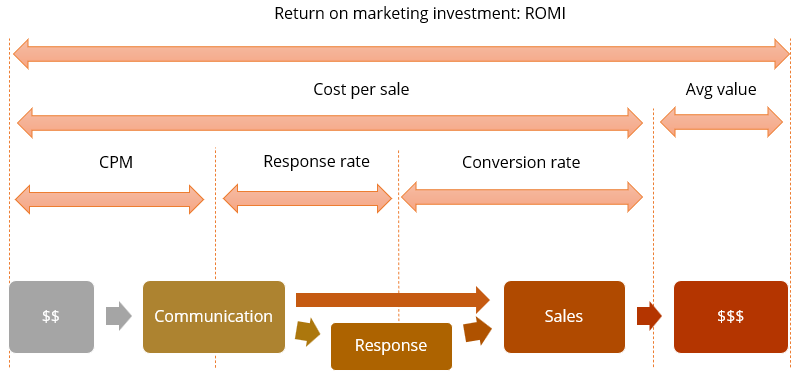Lord Kelvin.
Marketing Effectiveness Metrics
But the roads to long-term profitability are many, so marketers chart a course and use additional metrics to measure progress on that course.
Marketing campaigns have both short-term and long-term effects on sales. The short-term effect is the increase in sales within days to weeks; it occurs as people currently wanting your type of product or service become aware or got reminded of your offering. Short-term effect is measured via Return-on-Marketing-Investment, discussed below.
The long-term effect develops on the scale of months to years, as the people who are aware of your brand find themselves in want of that type of product or service, develop a habit of buying your product, and continue to use and recommend it to friends long after cessation of promotions. Success of a brand is captured in a concept called Brand Equity, discussed separately.
The key measure of marketing effectiveness is Return-on-Marketing-Investment (ROMI(p)), defined as profit generated by marketing effort divided by marketing costs. A value greater than 1 indicates self-sustaining marketing effort.
If you cannot calculate profit from marketing, these are the alternative metrics to use:

The key to these calculations is knowing how much revenue, sales, and profit is due to marketing efforts (see the diagram); the process of figuring this out is called attribution.
The baseline is the level of sales that occurs in lieu of any promotional effort, and is closely related to Brand Equity. While the authoritative sources suggest there is no single metric for BE, it could be argued that the level of sales that occurs "naturally" is the quantative measure of BE.
Note: The definitions of ROMI and ROAS vary somewhat between sources. Some define ROMI via profits and others via revenue, some would define ROAS as total revenue divided by ad spend. Without arguing technicalities, we want to point out the important bits: 1) profit is a more accurate metric, but is harder to calculate, hence using revenue is ok as the first step, and 2) only revenue attributable to marketing or advertising counts.
ROMI measures marketing end-to-end, but the journey from "money in" to extra sales and profits has several interim steps. Each step has its own independent metrics, collectively, they determine success of the marketing effort.

Communication is what delivers your message to the target audience. This could be in the form of advertising, influencer marketing, content, events, etc. If you use an advertising agency, you likely specify your requirements to them in terms of communication goals.
Communication is measured using:
Where there is communication, there should be a response. There is no unified metric; it could be visits to the website, checking out reviews, requesting more information, viewing your social media pages, or a combination. Response is more immediate than sales and can provide more details about performance of different parts of your campaign. Not all sales generate measurable interim response, but even a small fraction will make this metric useful for optimisation.
Other component metrics of ROMI are listed below. Each of these metrics tells its own story and should be monitored and improved.
| CPM cost-per-mille | Cost per thousands of impressions – perhaps the best-known contributor to the overall cost-per-sale and ROMI. Everyone wants to pay less, but cheap media often delivers poor quality audience and insufficient reach, repeating the ads over and over to the same people. |
| Response rate | Shows how well your communications align with their audience. All things being equal, messages that sit better with the audience will elicit higher response. This works within the same type of media, e.g. online ads where engagement is a click away will likely work better than a morning radio ad where people are on their way to work. |
| Clicks, CPC | This is important for search marketing, as it stands as a proxy for response, i.e. the number of visits to the website generated by search marketing approximately equals the number of clicks. Other forms of online advertising might generate response without clicks, e.g. a viewer would go to your site directly or find it via an organic listing in a search engine. |
| Conversion rate | Shows how well customer interest translates into sales. A low conversion rate indicates high friction, inconvenience, incorrect pricing etc in the buying process. |
| Average Value | This could be average sale value, or for repeat businesses, customer long-term value. |
In multi-channel marketing, the audience delivered by each channel would have different behaviours, resulting in unique values for communications, response, and conversion metrics.